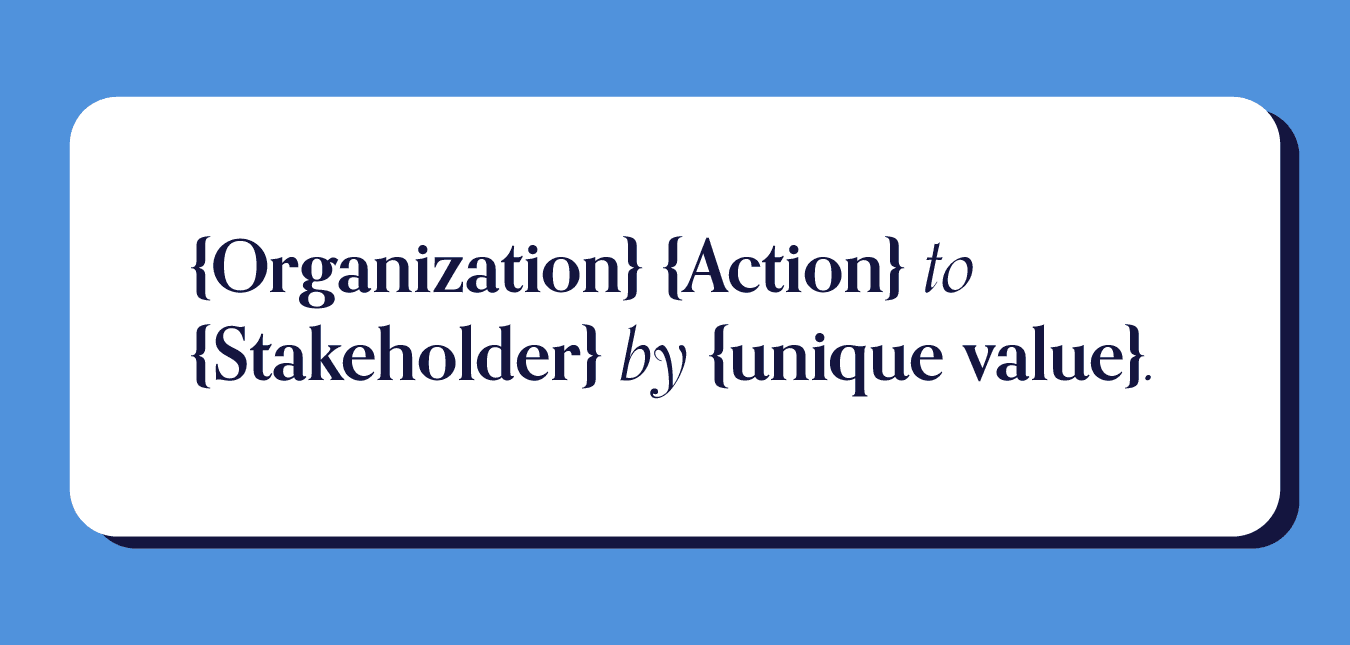If you click around on Uber’s website, you’ll likely come across this mission statement: “Uber’s mission is to reimagine the way the world moves for the better.”
Pretty catchy, right?
Mission statements are more than just a snappy statement about a company. They describe your purpose, goals, values, and what makes your brand unique. Naturally, mastering them is pretty important — especially in a world where 94% of global consumers engage with and reward companies that “have a strong purpose.”
Want to know how to craft a mission statement that matters? Read on to learn everything you need to know.
What Is A Mission Statement?
A mission statement is a 1-2 sentence description that explains your organization’s purpose and what you do for your staff, customers, and the wider community. Some mission statements also describe your long-term goals, environmental impact, position in your industry, and short-term objectives.
Mission statements should be succinct, transparent, and less than 100 words. The best mission statements are often the shortest — they limit themselves to only answering the “who,” “what,” “why,” “where,” and “how” of your organization.
Developing a strong mission statement can help your organization to:
- Convey its vision to investors and stakeholders
- Guide staff when it comes to making decisions for the organization and customers
- Help customers understand what you can do for them
- Set performance and quality standards
- Attract new staff members whose values align with your organization’s
Capturing the essence of your organization in a single sentence can be tricky. Very few businesses only offer one product or service, so you may find you need at least 1,000 words to explain all the great things your organization does.
Instantly create a powerful mission statement with CoSchedule’s Mission Statement Generator!
While this essay might be really inspiring, it’s doubtful your stakeholders will read it. So, here’s how to create an effective and short mission statement:
Step 1. Explain The Benefits Of Your Organization’s Products And/Or Services
The first step in creating your mission statement is to brainstorm the things your organization offers.
We suggest you brainstorm either in a large notebook, on a whiteboard, or in a blank document — you’ll probably come up with more answers than you might originally expect.
Start by listing down the core products and services your organization offers. Then, use them as a jumping-off point and list the benefits associated with each. Here are some categories of benefits to consider:
- Technological benefits. For example, access to automation, machine learning, Artificial Intelligence (AI), etc.
- Environmental benefits. For example, is your product made from recycled plastic, is your packaging recyclable, etc.
- Social benefits. For example, do your products make your customers seem more professional and organized?
- Cyber security benefits. For example, do your products protect customers against cyber threats, do they offer greater anonymity, etc.?
- Convenience benefits. Do your products make a typically complicated task simple?
- Time-saving benefits. For example, do your products save people time or eliminate a time-consuming task?
- Cost-saving benefits. Do customers save money by using your products?
- Emotion-driven benefit. How do your offerings make customers feel?
Don’t edit your list too much, but do highlight any benefits you feel are really core to your brand’s identity.
Step 2. List Your Stakeholders
Next, create a list of all the stakeholders who benefit from associating with your company. Anyone who has an affiliation with your organization is a stakeholder.
Stakeholders come in two different types:
- Internal stakeholders = those within your business like the staff.
- External stakeholders = those outside your business like suppliers.
Stakeholders have varying levels of investment in your company. Primary stakeholders contribute heavily to your work and are the most invested (for example, your CEO, CMO, and CFO). Secondary stakeholders contribute, but not as much (for example, a lawyer who works with your company contractually).
Here’s a list of possible stakeholders to consider for your mission statement:
- Customers
- Owners
- Members of the leadership team
- Investors
- Creditors
- Unions
- Employees
- Contractors
- Members of the local community
- Those within the same industry or niche
You’ll likely end up with quite a long list, so take the time to highlight 1-3 primary stakeholders. This shortlist should always include clients or customers.
Step 3. Identify 2-3 Company Goals
By this point, you will have gotten into the brainstorming grove. Keep the momentum going and list your company’s goals and objectives.
Goals are long-term, broad things that span multiple departments. Meeting net zero is a goal, for example.
Objectives are short-term, specific milestones that chart your progress towards your goal. Increasing your Facebook followers is a goal, for example. (Read this article for more examples of goals and objectives.)
Once you’ve developed a list of goals and objectives, edit your list until you are left with 2-3 goals that capture your company’s vision.
If you’re having trouble coming up with goals, use your company values and marketing plan as inspiration.
Step 4. Describe What Sets Your Company Apart From Its Competitors
Your competitive advantage is the thing that makes your brand stand out from competitors, so it’s definitely something you want to capture in your mission statement.
Before you start writing your statement itself, take a moment to identify and describe your organization’s competitive advantage. Broadly, there are five types of competitive advantages:
- Cost-based advantages
- Differentiated advantages
- First mover advantages
- Time-based advantages
- Technology-based advantages
A great place to look for inspiration for your competitive advantage is your brand’s SWOT, 5C’s, and PEST analyses — available in your marketing documentation.
Don’t confuse your competitive advantage with your Unique Value Proposition (UVP). Your UVP is specific to a good/service, whereas your competitive advantage applies to your company as a whole.
Unique Value Proposition:
A unique value proposition (UVP) is the core benefit or solution that differentiates your product or service from the competition and positions it as the best possible option on the market.
Step 5. Summarize Into 1-2 Sentences
Finally, take inspiration from the brainstorming you did over the last four steps and your marketing and summarize it into 1-2 sentences to form your mission statement.
You’ll need to make sure you cover these three crucial things:
- Your purpose
- Your values as an organization
- Your organization’s goals
If you’re struggling to formulate your statement, try this formula…
1. {Organization}{action} to {stakeholder} by {unique value}.

For example: “Border States provides value to our customers by delivering innovative product and supply chain solutions.”
… or this one…
2. To {action} — {how}.

For example, Starbucks’ mission statement is: “To inspire and nurture the human spirit — one person, one cup, and one neighborhood at a time.”
To help you create the best mission statement possible, here are eighteen mission statement examples to inspire you:
1. CoSchedule
CoSchedule’s mission statement:
Pursue growth, empower our team, and build simple products that are uniquely helpful, fun to use, and consistently punch above their weight.
What makes it a good mission statement:
- It captures CoSchedule’s USP
- It mentions CoSchedule’s amazing team
- It describes CoSchedule’s standards for quality
2. Apple
Apple strives to bring the best personal computing experience to students, educators, creative professionals, and consumers around the world through its innovative hardware, software, and internet offerings.
We like Apple’s mission statement because it includes the diverse groups of people who use Apple products. It also includes Apple’s internet offerings, which are sometimes overlooked in favor of its hardware.
3. The Walt Disney Company
The mission of The Walt Disney Company is to entertain, inform and inspire people around the globe through the power of unparalleled storytelling, reflecting the iconic brands, creative minds and innovative technologies that make ours the world’s premier entertainment company.
We like The Walt Disney Company’s mission statement because it gets to the heart of why people love Disney: the storytelling.
4. Amazon
Amazon is guided by four principles: customer obsession rather than competitor focus, passion for invention, commitment to operational excellence, and long-term thinking. Amazon strives to be Earth’s most customer-centric company, Earth’s best employer, and Earth’s safest place to work.
We like Amazon’s mission statement because it outlines the four key principles that the brand is built on. It’s also great because it mentions both customers and staff and Amazon’s goals for both.
5. Netflix
At Netflix, we want to entertain the world. Whatever your taste, and no matter where you live, we give you access to best-in-class TV series, documentaries, feature films and mobile games. Our members control what they want to watch, when they want it, with no ads, in one simple subscription.
We like Netflix’s mission statement because it describes Netflix’s USP really simply. It’s also great that it emphasizes Netflix’s global reach.
6. Tesla
Tesla’s mission is to accelerate the world’s transition to sustainable energy.
We like Tesla’s mission statement because it’s short but descriptive. It also features Tesla’s environmental goals, which makes it stand apart from the other mission statements featured in this article.
7. Nike
Bring inspiration and innovation to every athlete in the world.
We like Nike’s mission statement because it’s short but poetic. Nike’s website clarifies that “if you have a body, you are an athlete.”
8. McDonald’s
Our mission is to make delicious feel-good moments easy for everyone.
We like McDonald’s mission statement because it focuses on how Mcdonald’s wants customers to feel. This is quite a unique approach, but it definitely pays off.
9. Walmart
Walmart’s mission is to save people money so they can live better.
We like Walmart’s mission statement because it’s very straightforward and cuts straight to what people love about Walmart: the low prices.
10. Alphabet
Empowering great entrepreneurs and companies to flourish.
We like Alphabet’s mission statement because it sticks to what Alphabet wants its impact on the world to be. Alphabet doesn’t really need a wordy introduction — its brands already touch most people’s lives daily.
11. Microsoft
Our mission is to empower every person and every organization on the planet to achieve more.
We like Microsoft’s mission statement because it really emphasizes Microsoft’s global reach. It would be difficult to find a person or company that has never used a Microsoft product.
This statement is also great because it emphasizes that Microsoft isn’t a B2B or B2C brand — it’s both (plus a B2G brand, a B2S brand, etc.).
12. Salesforce
You’re changing the world. We’re here to help.
We like Salesforce’s mission statement because it includes the company’s dedication to Corporate Social Responsibility (CSR). In 2021, Salesforce’s Annual Social Value (ASV) was $1.5 billion, and it delivered $23 million in pro bono value to the nonprofit sector.
13. Nissan
As a company worthy of trust, Nissan provides unique and innovative automotive products and services that deliver superior measurable values to all stakeholders.
We like Nissan’s mission statement because it’s very professional and formal. Such an approach is well suited to Nissan’s branding and stakeholders.
14. Target
To help all families discover the joy of everyday life.
We like Target’s mission statement because it doesn’t focus on Target as a company but on how it wants to impact customers. The mission statement is also very broad and applies to staff, investors, suppliers, and other stakeholders.
15. Coca-Cola
Coca-Cola has a purpose statement and a vision statement. Its purpose statement is:
Refresh the world. Make a difference.
Its vision statement is:
Our vision is to craft the brands and choice of drinks that people love, to refresh them in body & spirit. And done in ways that create a more sustainable business and better-shared future that makes a difference in people’s lives, communities, and our planet.
We like Coca-Cola’s vision and purpose statements because they use the brand’s products as a jumping-off point for how Coca-Cola wants people to feel. It also touches on the brand’s CSR commitments and community work.
16. Toyota
Toyota will lead the future mobility society, enriching lives around the world with the safest and most responsible ways of moving people. Through our commitment to quality, ceaseless innovation, and respect for the planet, we strive to exceed expectations and be rewarded with a smile. We will meet challenging goals by engaging the talent and passion of people who believe there is always a better way.
We like Toyota’s mission statement because it focuses on Toyota’s work for the future. The final sentence also honors Toyota’s talented staff and the role they play in pushing the company forward.
17. Adobe
Changing the world through digital experiences.
We like Adobe’s mission statement because it’s extremely short but captures the core of the company’s products: digital experiences. This mission statement could also double as a slogan, so it’s a very clever marketing strategy.
18. PayPal
Our mission is to democratize financial services to ensure that everyone, regardless of background or economic standing, has access to affordable, convenient and secure products and services to take control of their financial lives.
We like PayPal’s mission statement because it explains why PayPal is such a popular service without using buzzwords. The PayPal team has also packed the statement full of powerful words like “democratize,” “affordable,” “convenient,” “secure,” and “take control.” These make the statement quite punchy.
What Is An Example Of A Mission Statement?
Here’s a mission statement from Apple: “Apple strives to bring the best personal computing experience to students, educators, creative professionals, and consumers around the world through its innovative hardware, software, and internet offerings.”
What Are The 3 Key Things A Mission Statement Should Have?
A mission statement needs to include:
- Your purpose
- Your values as an organization
- Your organization’s goals
It’s also common to see organizations mention their stakeholders and competitive advantage in their mission statements.
What Is A Good Mission Statement?
A good mission statement is short (ideally, 100 words or less), direct, and clearly explains your organization’s purpose, values, and goals.

